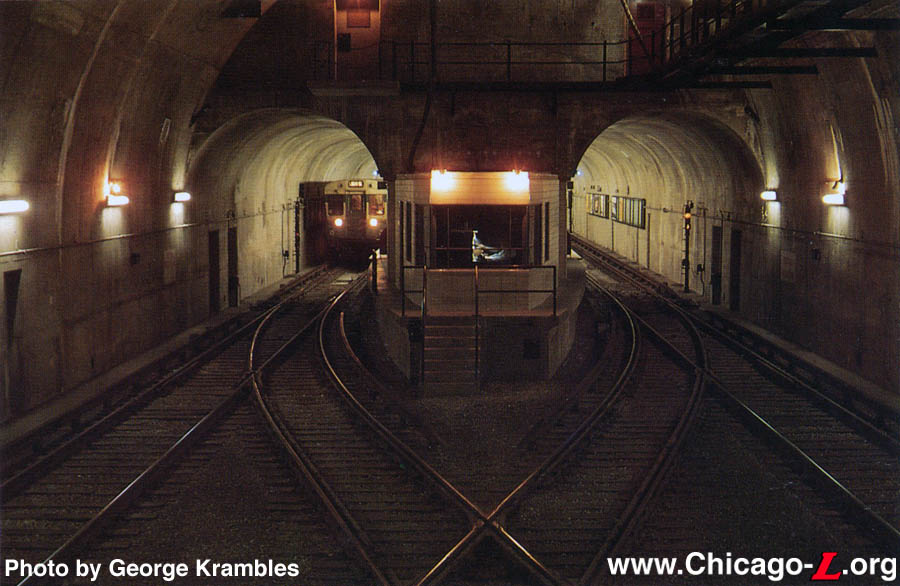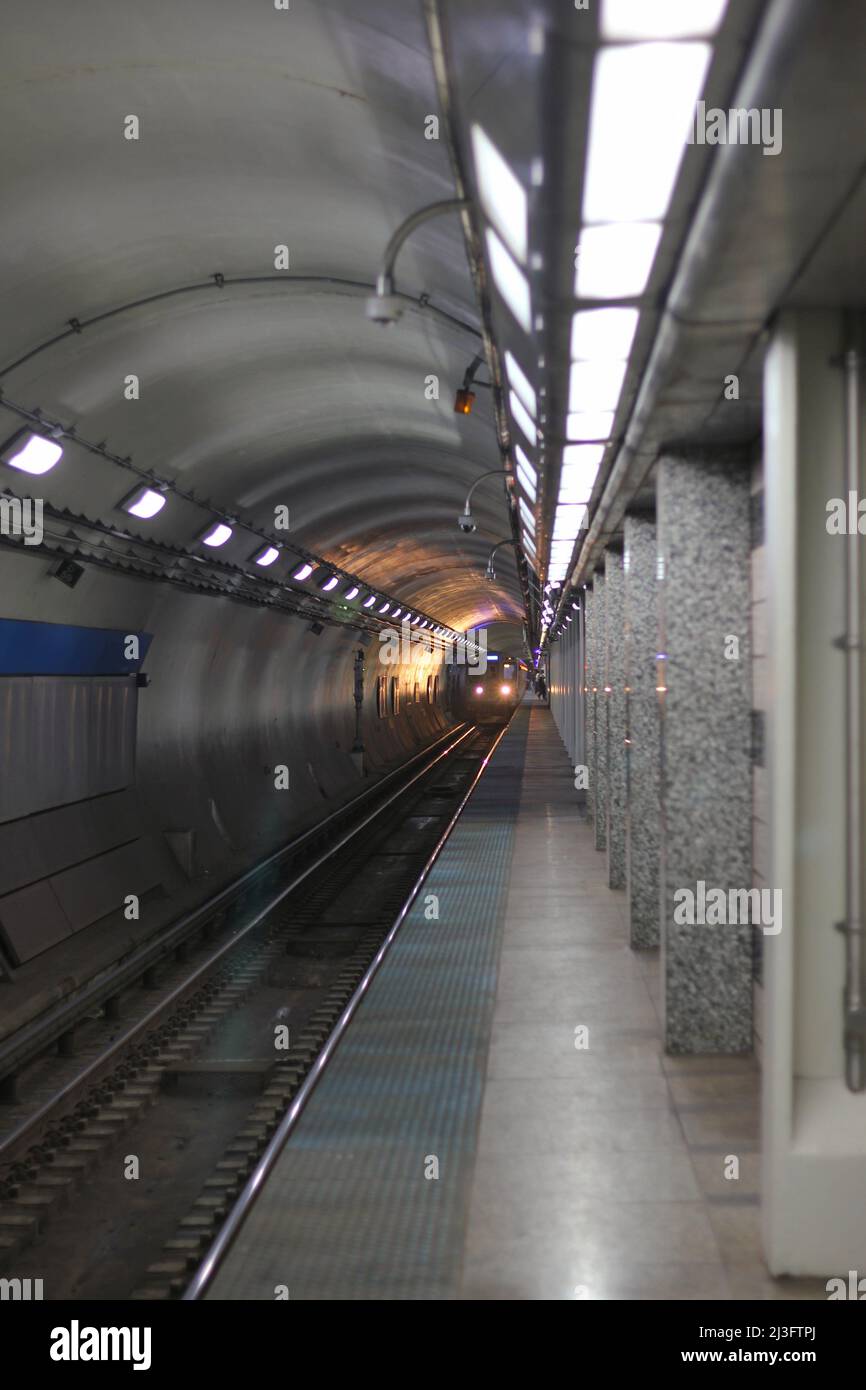The only dumb train stunt I ever did was in Japan–trains were usually 5 or 7 cars long, had open doors between the cars like bendy buses have and the floors were nice and smooth. I’d start at the head car of a mostly deserted train on my skateboard, then as it took off I’d stay immobile in relation to the station while the train picked up speed under my wheels until I’d crash into the door of the final car. Turn around and when the train braked for the next station I’d go rocketing back to the front. There were about ten stops between where I started and my home station and I’d zoom every one of them. Got some annoyed looks from other passengers, but Japanese people are polite, especially to gaijin kids and I never got into trouble for it.
In college a friend and I hopped a freight train one Thanksgiving weekend. We thought it would be exciting and romantic. The first night on the train was about the most uncomfortable I’ve ever been in my life. Sleeping was impossible. It was like trying to sleep while a large strong person repeatedly slams your head against the floor.
Freight cars are sprung strongly. Decades ago I rode the Cumbres and Toltec when they were still using converted DRGW boxcars before they acquired/built coaches. I’ve also ridden in a std gauge gon on a McCloud Railway railfan trip. Both were notably than your regular passenger service.
Back in the 1930s when my father was a teen, he decided to ride the blinds – between the tender and baggage car – from somewhere on the Peninsula to Santa Barbara. It was on what he thought was a local, easing along at 30 to 40mph, but it was an express, more like 60 or 70. The extra speed meant the wind buffeting and motion was a lot more than he was prepared for, and when the train stopped for water about an hour and a half out, he basically tumbled to the ground on rubber legs.
This caught the attention of the fireman who had moved to the top of the tender to put in the water and he said, “Man, you’re lucky. We don’t usually stop until San Luis Obispo,” another three hours south. He’d never have lasted that long.
Wow. I’m reminded that my sister, today she’s 60, when she was in her early 20s for one summer between college years, she and her boyfriend hopped freight cars all summer long and travelled all over. They covered a good part of the lower 48. This was about 40 years ago.
On a not-totally-unrelated note, when white settlers discovered Yellowstone, they would throw rocks, logs, and other things into the geysers so they could watch them fly out when the geysers erupted. More than one person died as a result.
We haven’t changed all that much.
Not to be confused with “skeet surfing”.
https://youtu.be/8WFHnHYmmsY?si=Ey3PwPMhTqeNreBR
Teenagers have always done lots of things with cars:
Oh lordy, kids do stupid things. When I was a kid, several of us used to climb out onto the superstructure of a railroad trestle and wait for trains to come across. The small platform we could stand on was probably 30’ above the creek below, a fall from which would likely be very injurious or result in dying in the sucking mud of the creek. I slipped once, but my friend grabbed me. That was the last time for me.
Just surfing on top of a train? Pfffft. How about getting some while subway surfing! ![]()
Did you live in Santa Carla by any chance? ![]()
Now that’s what I call some wild sex.
Probably around 1991, we were 18 and a friend of mine had a Suzuki Samuri. It had the spare tire mounted on the back and a luggage rack. It was laid out perfectly such that you could, facing front, straddle the tire and hold on to the luggage rack.
We all rode many, many miles like that. It was surprisingly comfortable.
Unsurprisingly, it’s still happening.
I assume “subway surfing” can only be done on outdoor portions of track. Approaching a tunnel, you would have to duck or jump (if on the roof), or jump (if you were hanging on to the side).
Are there cases of it being done in tunnels?
I expect it depends entirely on the tunnel clearance, for which, of course, the answer will vary between subway systems, and even between tunnels within a system.
As well as varying by different cars in a specific train, potentially.
Commuter trains probably have a consistent consist, but it’s the wild west if you hop a cargo train.
For example, here are a couple of pictures of tunnels and subway train cars on Chicago’s “L” system. The cars themselves are essentially square in profile (with a bit of a domed roof); the tunnels are round or oval in cross-section, built for a single line of track to run through, with considerable clearance above the roofs of the train cars (particularly near the center of the car). However, being near the corner/edge of the car would appear to be a lot more dangerous, as it looks like there is far less clearance (as shown in the first photo below).
https://www.railworks.com/sites/default/files/2018-10/ctaredlinetunnel_finished-section-hero.jpg
On the other hand, here’s a picture of a CTA L train, emerging from a different tunnel (this one near O’Hare airport) – the tunnel is built for two tracks, is rectangular in profile, and there appears to be very little headspace above the train cars.
I think of subways as people movers with stops every couple of blocks so it’d be easy to get on/off w/o going too far whereas a freight train could go for many miles & would be more of a hobo riding that, maybe to get to another city/state
In the town where I grew up, there is a railroad trestle which sits high above the Little Darby. It has long been known that, any young man worth his salt will engage in the ancient rite of passage known as Jumping Off the Trestle.
Yes, I have done this. Twice. That is NOT to brag. I am lucky to be alive.
A few of us were curious about it, so we headed back through the woods on the tracks, armed with recently-acquired AP Physics knowledge regarding velocity and time, etcetera, and were determined to discover the height of the thing.
76’. (Just a little more, if memory serves.)
Standing at the prescribed location of exit, one is astride a concrete level that is about 3’ wide; enough to keep one from the dangers of an oncoming train, although I wouldn’t want to be the one to find out…
The gravel base is cleared out from so many people jumping, through the years. You know you are in the correct spot, though, due to a rather rusty bolt extending out from the side of the bridge by about three feet, and which is lower than the level you are on by three or four feet. You have to clear it, but not by a lot. Once your momentum starts, there’s no stopping it.
From this vantage point, looking down, there are two noteworthy visible obstacles to success. First, the least dangerous of the two, is a submerged box car from a long-ago derailment which has been confirmed by a local historian, as well as microfilm/fiche of the incident as told in various local newspapers. It is off to the left of the target zone, and far enough away that it presents no real hazard, really only serving as the basis of a silt-covered island. If you didn’t know it was there, you wouldn’t be blamed for missing the clearly square corner of the little slice of land.
The second, more dangerous thing in the water is the target you are aiming for. You see, although the water is (nearly) sufficiently deep in this area of the creek to prevent certain death, the deepest portion is centered between four wooden pilings which held up the previous railroad bridge, abandoned when the railroad was raised. Please believe me when I say that, from on the bridge, it looks like those pilings are about five feet apart from one another. (In reality, they are a much more reasonable, yet still-within-the-realm-of-danger 20’-25’ apart.)
Yep, you are aiming for the center of THAT. Just thinking about it puckers me up.
Again, I did it. Twice. I saw guys do flips and all manner of silliness off that thing in misguided attempts at bravado. Not me. It was all I could do to get my legs straight. It was terrifying.
I am lucky to be alive.



